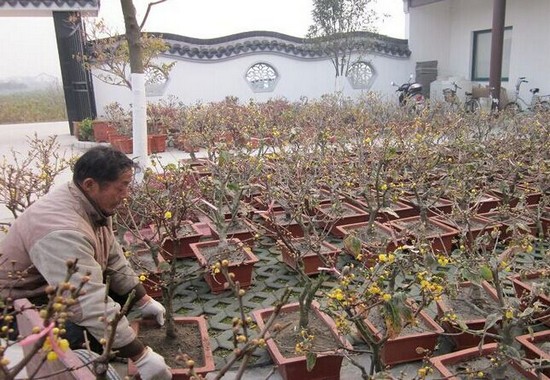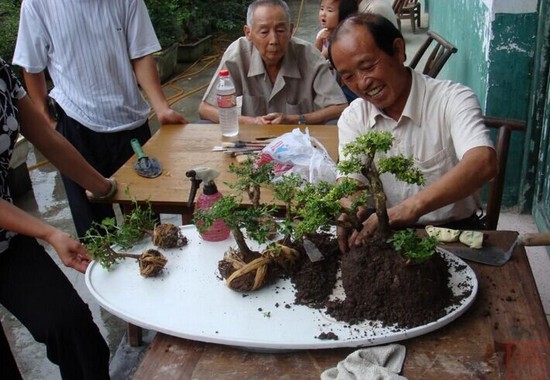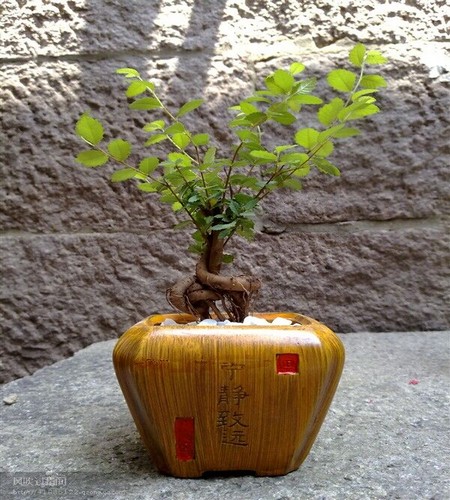Teach you to cultivate wintersweet bonsai quickly.
Chimonanthus is a deciduous shrub with opposite leaves, rough leaves, and flowers on new branches (that is, annual branches) born in the axils of previous annual branches. The flowering period is from December to February, and the fruiting period is from August to September of the following year. Its adaptability is strong, drought resistance, cold resistance, like light, like fertilizer, not resistant to bituminous coal. Resistant to pruning. Afraid of wind, waterlogging, alkali and clayey soil. Prunus mume can be divided into two kinds: vegetarian plum and meat plum. The methods of grafting propagation and cultivation are as follows:

1. Sowing and propagation: from July to August, the jar-shaped receptacle was harvested, the seeds were taken out, and the seeds were sown with harvest and germinated in about 10 days.
2. Split-plant propagation: this method is mainly used in the propagation of vegetarian plum. Because its root side clump is luxuriant, so all can split, when planting, it is appropriate to choose the sunny dry place, the soil should not be too deep. Shortening the branches and applying some dilute fertilizer will make it easier to grow.
3. Ground planting and cultivation: if it is left to nature, the branches are cluttered and the shape of the tree is not beautiful, so it is generally cultivated alone. After one year of planting, a strong branch is selected and fertilized, and the rest of the branches are cut off, which can be as high as 1-2 meters this year.
4. old root grafting: cutting method is slightly better than relying on grafting method. One month before cutting, go to the top tip first, so that the nutrition is concentrated in the middle of the branch, the ear should not be cut deep, the slightly exposed xylem is suitable, the rootstock should not be cut 3-6 cm from the ground, and the rootstock should not be cut deeply. Finally, the crushed soil is congested into the shape of steamed bread at the grafting site until the top of the scion is covered, and the soil is half-dry and half-wet. A month later, the soil is removed to help the buds grow, and at the same time, the sprouting on the rootstock is cut off. If the weather is bad, the soil should still be covered.
Measures for rough cuttage survival:
The cutting base should avoid direct sunlight and no stagnant water, wax plum is resistant to shade and afraid of dampness. The culture soil can be well mixed with river sand, vegetable garden soil and rotten leaf soil. Before use, it can be frozen in the sun to eliminate insect pests, grow less grass and prevent infection and mildew. With the selection of dried cuttings, there are many varieties of Chimonanthus, and the survival rate of wild Chimonanthus (Gouya plum) is higher, which can reach more than 95%, followed by Chimonanthus praecox. The survival rate of excellent varieties such as Xinkou and lotus is low. More than one year old, the bud eyes are more rough, sawed into 15 cm-25 cm length, depending on the thickness. In the method of cutting, the rough stem should be cut off with branches to prevent more new buds, consume nutrients (only two or three branches are left when sprouting, and the rest are peeled off), seal the upper and lower wounds with candle oil to prevent infection and rot, and cuttings are cut on the seedling bed or in the flowerpot. It is better to leave only 1-2 bud eyes on the soil surface (or oblique cuttings to facilitate the connection of the Beginning of Autumn after survival). After inserting and pouring water, we must pay attention to heat preservation and moisturizing.
Measures for rapid cultivation and shaping after rough cutting and sprouting, when growing 2-4 pairs of leaf buds, that is, picking the heart for 2-3 times, it can be stereotyped in the same year, cut again in spring, and will be full of flowers 2-3 years later, warm and lovely. Wild Chimonanthus przewalskii (Prunus mume) has strong vitality, fast sprouting and high survival rate. It will pick the heart when it is 4-5 pairs of leaves, and before the Beginning of Autumn, the base of the sprouting branch has been lignified. It can be connected in vitro or in vitro. The scion is selected to sprout branches this year and form flower buds through coring forks. After this branch is grafted, it will continue to grow 2-3 leaves, pick the heart again, and stop picking the heart in early August. At that time, a small bonsai was formed, and there were flowers to enjoy.
Depending on the management after grafting, the two rootstocks are cuttings of the same year, although they have survived, but the roots are underdeveloped, and some of them have just taken root and should be placed in a ventilated and sunshaded place. In vitro connection should pay more attention to avoid the sun but also cover plastic bags to moisturize. The branches and leaves at the upper end of the rootstock cannot be cut off in the same year, so as not to affect the survival and growth. Pay attention to water and fertilizer management, just rely on the connection, can not be caught in the rain into the wound, to prevent festering. If you don't dry or water it, you will water it thoroughly. The fertilizer is mainly dilute cake and dung water. After two months, the ears of the two plants were cut off and grafted in vitro. In 15-20 days, the moisturizing plastic bags could be gradually removed and placed in the sun shelter and ventilated place for careful management.
This cultivation of Chimonanthus bonsai takes only 1-3 years to get a pot of wax plum bonsai with strange dryness, beautiful shape and rich aroma, which is really known as "silent poetry, three-dimensional painting".
Time: 2019-06-12 Click:
- Prev

How to model bonsai? Bonsai modeling method
Bonsai is a kind of display with a long history in our country, which makes woody plants, herbs or water, stone, etc., after artistic processing, planting or arrangement in the basin, making it a microcosm of nature. According to different materials, bonsai can be divided into two categories: tree Toona bonsai and landscape bonsai.
- Next

Cultivation of Elm Bonsai
Ulmus pumila usually sows and propagates. From October to November, the seeds are ripe and the fruit wings are yellowish brown. They should be harvested in time, spread out and dried, sundries removed and stored in bags. Sowing, sowing or strip sowing in March of the following spring. The row spacing of strip sowing is 25 cm, sowing on a windless and sunny day, covered with fine soil, so as to see no seeds.
Related
- Fuxing push coffee new agricultural production and marketing class: lack of small-scale processing plants
- Jujube rice field leisure farm deep ploughing Yilan for five years to create a space for organic food and play
- Nongyu Farm-A trial of organic papaya for brave women with advanced technology
- Four points for attention in the prevention and control of diseases and insect pests of edible fungi
- How to add nutrient solution to Edible Fungi
- Is there any good way to control edible fungus mites?
- Open Inoculation Technology of Edible Fungi
- Is there any clever way to use fertilizer for edible fungus in winter?
- What agents are used to kill the pathogens of edible fungi in the mushroom shed?
- Rapid drying of Edible Fungi

